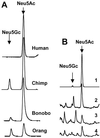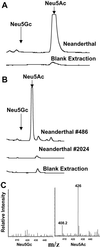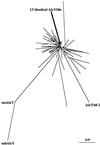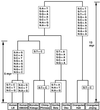Inactivation of CMP-N-acetylneuraminic acid hydroxylase occurred prior to brain expansion during human evolution
- PMID: 12192086
- PMCID: PMC129338
- DOI: 10.1073/pnas.182257399
Inactivation of CMP-N-acetylneuraminic acid hydroxylase occurred prior to brain expansion during human evolution
Abstract
Humans are genetically deficient in the common mammalian sialic acid N-glycolylneuraminic acid (Neu5Gc) because of an Alu-mediated inactivating mutation of the gene encoding the enzyme CMP-N-acetylneuraminic acid (CMP-Neu5Ac) hydroxylase (CMAH). This mutation occurred after our last common ancestor with bonobos and chimpanzees, and before the origin of present-day humans. Here, we take multiple approaches to estimate the timing of this mutation in relationship to human evolutionary history. First, we have developed a method to extract and identify sialic acids from bones and bony fossils. Two Neanderthal fossils studied had clearly detectable Neu5Ac but no Neu5Gc, indicating that the CMAH mutation predated the common ancestor of humans and the Neanderthal, approximately 0.5-0.6 million years ago (mya). Second, we date the insertion event of the inactivating human-specific sahAluY element that replaced the ancestral AluSq element found adjacent to exon 6 of the CMAH gene in the chimpanzee genome. Assuming Alu source genes based on a phylogenetic tree of human-specific Alu elements, we estimate the sahAluY insertion time at approximately 2.7 mya. Third, we apply molecular clock analysis to chimpanzee and other great ape CMAH genes and the corresponding human pseudogene to estimate an inactivation time of approximately 2.8 mya. Taken together, these studies indicate that the CMAH gene was inactivated shortly before the time when brain expansion began in humankind's ancestry, approximately 2.1-2.2 mya. In this regard, it is of interest that although Neu5Gc is the major sialic acid in most organs of the chimpanzee, its expression is selectively down-regulated in the brain, for as yet unknown reasons.
Figures





References
-
- Schauer R. Sialic Acids: Chemistry, Metabolism and Function, Cell Biology Monographs. Vol. 10. New York: Springer; 1982.
-
- Angata T, Varki A. Chem Rev. 2002;102:439–470. - PubMed
-
- Varki A. Yearbook Phys Anthropol. 2002;44:54–69.
-
- Muchmore E A, Diaz S, Varki A. Am J Phys Anthropol. 1998;107:187–198. - PubMed
Publication types
MeSH terms
Substances
Associated data
- Actions
- Actions
- Actions
- Actions
- Actions
Grants and funding
LinkOut - more resources
Full Text Sources
Other Literature Sources
Molecular Biology Databases
Research Materials
Miscellaneous

